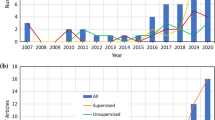Abstract
Landslide is one of the most widely distributed mass movements in mountainous areas. With its wide spreading, abrupt, and seasonal characteristics, landslide always causes huge risks towards transportation, human settlements, industrial and mining plants, water resources facilities, and hydropower stations. Abe Barek landslide, which happened in the morning of May 2, 2014, in Ago District, Badakhshan Province, Afghanistan, buried 86 houses and took the lives of almost 2700 people. Many factors triggered the occurrence of this disaster. Firstly, the landslide-impacted area has a complex geologic structure that bears concentrated faults with mountain slopes covered by thick loess. Secondly, at the time of landslide, a continuous rainfall had deepened the level of moisture in the loess layer, which made the loess mass heavier and changed the soil body’s mechanical properties. Thirdly, a similar landslide once happened on the same slope, which destroyed the land cover and transformed the topology of the slope. In addition, farming and irrigating activities may have also affected the stability of loess mass in this area. Upon an initial examination of landslide distribution in Badakhshan Province by using high-resolution remote sensing images from Google Earth, a total number of 609 landslide sites were identified in this area, and a landslide susceptibility assessment was completed by utilizing weight-of-evidence method. Several suggestions on landslide risk reduction in this remote mountainous area are proposed at the end of this paper.














Similar content being viewed by others
References
AccuWeather Company (2014) Daily precipitation of Fayzadad, Afghanistan. <http://www.accuweather.com/en/af/feyzabad/2149/air-travel-april-weather/2149?monyr=4/1/2014&view=table>
Afghan Meteorological Authority (2012) Climate normals (1956–1983 period): Faizabad
Azam Ahmed (2014) ‘No hope’ for those buried by mudslide, Afghanistan official says. The New York Times. <http://www.nytimes.com/2014/05/04/world/asia/aid-effort-begins-at-scene-of-afghan-landslides.html?_r=1>
Bettis EA, Prior JC, Hallberg GR, Handy RL (1986) Geology of the loess hills region. In: The Proceedings of the Iowa Academy of Science, vol. 93, no. 3. Iowa Geological Survey, Iowa State University, Ames Iowa, pp. 78–85
Bicheron P, Huc M, Henry C, Bontemps S, Lacaux JP (2008) GlobCover: products description manual. European Space Agency
Brabb EE (1991) The world landslide problem [J]. Episodes 14(1):52–61
Deobrich JL, Wahl RR (2006) Geologic and mineral resource map of Afghanistan [Map]. 1: 850,000. USGS
ESRI (2010) National geographic world map. <http://services.arcgisonline.com/ARCGIS/rest/services/NatGeo_World_Map/MapServer>
Geodesy and Cartography Head Offices (1985) National atlas of the Democratic Republic of Afghanistan [M]. Organization for surveying and cartography. GEOKART, Warsawa
Jarvis A, Reuter HI, Nelson A, Guevara E (2008) Hole-filled SRTM for the globe version 4, available from the CGIAR-CSI SRTM 90m Database <http://srtm.csi.cgiar.org>
Muller L (1964) The rockslide in the Vaiont valley [J]. Rock Mech Eng Geol 2:148–212
OCHA (2014) Badakhshan Province: landslide in Argo district [Map]. <http://afg.humanitarianresponse.info>
Sawatzky DL, Raines GL, Bonham-Carter GF, Looney CG (2009) Spatial Data Modeller (SDM): ArcMAP 9.3 geo-processing tools for spatial data modeling using weights of evidence, logistic regression, fuzzy logic and neural networks
Shroder JF, Weihs BJ, Schettler MJ (2011a) Mass movement in north Afghanistan [J]. Phys Chem Earth 36:1267–1286
Shroder JF, Schettler MJ, Weihs BJ (2011b) Loess failure in northeast Afghanistan [J]. Phys Chem Earth 36:1287–1293
UN (2014) Afghanistan: UN relief officials visit landslide-hit north-eastern province. <http://www.un.org/apps/news/story.asp?NewsID=47722>
UNFPA (2003) Badakhshan: a socio-economic and demographic profile. <http://afghanag.ucdavis.edu/country-info/Province-agriculture-profiles/unfr-reports/All-Badakhshan.pdf>
UNOSAT (2014) Update: landslide in Ab Barek, Badakhshan Province, Afghanistan [Map]. 1:5,500 http://www.unitar.org/unosat/
USGS (2012) Historic world earthquakes. <http://earthquake.usgs.gov/earthquakes/world/historical.php>
Wang ZH (2007) Remote sensing for landslide survey, monitoring and evaluation [J]. Remote Sens Land Resour 1:10–15
Wang NQ, Zhang ZY (2005) Researches on loess landslides risk [M]. Lanzhou University Press, Lanzhou
Wheeler RL, Rukstales KS (2007) Seismotectonic map of Afghanistan and adjacent areas. US Geological Survey Open-File Report 2007–1104
Wu JS, Tian LQ, Kang ZC et al (1993) Debris flow and control [M]. Science Press, Beijing
Zhong LX (1999) Case study on significant geo-hazards in China [J]. Chin J Geol Hazard Control 10(3):1–6
Acknowledgments
This research was supported by the Key Research Program of the Chinese Academy of Sciences (Grant No.. KZZD-EW-08-01), National Natural Science Funds of China (Grant No. 41401007), Open Fund for Sichuan Engineering Research Center for Emergency Mapping & Disaster Reduction (Grant No. K2014B011), and Open Fund for Surveying and Mapping Geographic Information Bureau of National Key Laboratory of Digital Mapping and Land Information Engineering (Grant No. DM2013SC01). This study was also partially supported by core funds of ICIMOD contributed by the governments of Afghanistan, Australia, Austria, Bangladesh, Bhutan, China, India, Myanmar, Nepal, Norway, Pakistan, Switzerland, and the UK.
Author information
Authors and Affiliations
Corresponding author
Rights and permissions
About this article
Cite this article
Zhang, J., Gurung, D.R., Liu, R. et al. Abe Barek landslide and landslide susceptibility assessment in Badakhshan Province, Afghanistan. Landslides 12, 597–609 (2015). https://doi.org/10.1007/s10346-015-0558-5
Received:
Accepted:
Published:
Issue Date:
DOI: https://doi.org/10.1007/s10346-015-0558-5




